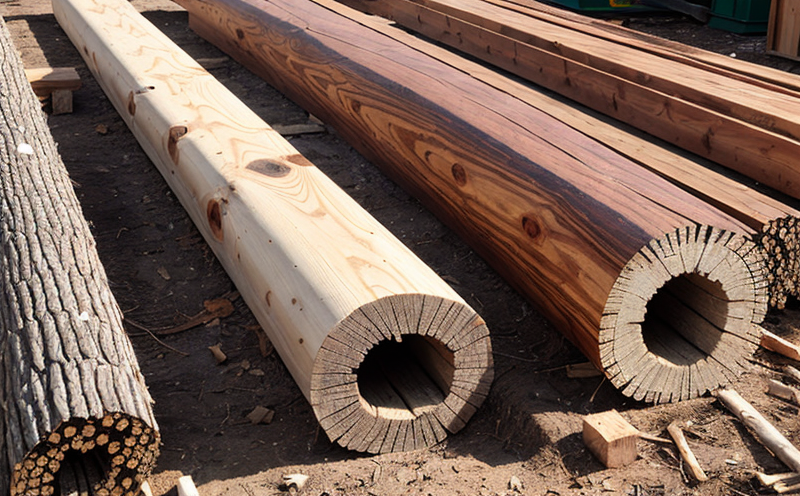White Rot Fungi Resistance Testing in Wood
White rot fungi resistance testing is a critical process in agriculture and forestry that ensures wood products maintain their integrity under challenging environmental conditions. This type of testing is essential for industries such as construction, furniture manufacturing, and outdoor structures where long-term durability is paramount.
The process involves exposing wooden specimens to specific strains of white rot fungi under controlled laboratory conditions to simulate real-world scenarios. The goal is to assess the wood's resistance to fungal degradation, which can lead to structural failure or aesthetic issues over time. This testing helps manufacturers and designers make informed decisions about material selection and preservative treatments.
White rot fungi are a group of decomposer fungi that break down lignin and cellulose in wood. These fungi play a crucial role in the natural decomposition cycle but can be detrimental to human use of wood products. By conducting resistance testing, industries can identify the best methods for preserving wood against fungal attack.
The tests typically involve placing wooden samples in incubators where they are exposed to controlled amounts of moisture and temperature. The fungi are introduced into these environments, and the specimens are monitored over time. Various factors such as the type of wood, its chemical composition, and the specific strain of fungus used can influence the outcome.
Understanding the resistance levels of different wood species is crucial for sustainable forestry practices. By identifying which woods are more resistant to fungal attack, we can promote the use of these species in applications where durability is critical. This not only aids in reducing waste but also supports eco-friendly construction and manufacturing processes.
The importance of white rot fungi resistance testing extends beyond mere compliance with regulations. It plays a vital role in ensuring product quality and customer satisfaction. By conducting rigorous tests, manufacturers can enhance their reputation for providing high-quality products that meet or exceed industry standards. This is particularly important in sectors where wood is used extensively, such as the construction industry.
Moreover, this testing helps in developing more effective preservatives and treatments. The insights gained from these tests can lead to the creation of innovative solutions that not only protect wood but also extend its lifespan. This contributes significantly to sustainable development by reducing the need for frequent replacements and repairs.
In summary, white rot fungi resistance testing is a cornerstone of quality assurance in agriculture and forestry. It ensures that wooden products meet the highest standards of durability and longevity, thereby contributing to both economic efficiency and environmental sustainability.
Scope and Methodology
The scope of our white rot fungi resistance testing service encompasses a comprehensive range of parameters that are crucial for assessing wood's resistance. Our methodology is designed to provide accurate and reliable results, ensuring the quality and durability of wooden products.
- Type of Tests: We conduct both qualitative and quantitative assessments using various standardized methods.
- Specimen Preparation: Specimens are cut from different wood types and sizes to ensure a representative sample for testing.
- Fungus Strains: We use specific strains of white rot fungi that are known to cause significant damage in the field.
- Incubation Conditions: Controlled temperature, humidity, and light levels simulate natural conditions but within a laboratory setting.
The testing process involves placing the specimens in controlled environments where they are exposed to the selected fungi. Over time, we monitor the extent of fungal degradation on the samples. The results provide valuable insights into the wood's resistance properties.
For more detailed information about our specific procedures and methodologies, please refer to relevant international standards such as ISO 6580:2019 for durability testing of wood preservatives. These guidelines ensure that our tests are consistent with industry best practices.
Eurolab Advantages
At Eurolab, we pride ourselves on offering top-tier white rot fungi resistance testing services tailored to meet the needs of various sectors including agriculture and forestry. Our advantages lie in our state-of-the-art facilities, experienced professionals, and commitment to precision.
- State-of-the-Art Facilities: We possess cutting-edge laboratories equipped with advanced instrumentation for precise measurements and observations.
- Experienced Professionals: Our team comprises highly trained experts in wood science and material testing who bring extensive knowledge and expertise to every project.
- Comprehensive Reporting: We provide detailed reports that not only document the test results but also offer recommendations for improvement based on our findings.
In addition to these technical advantages, Eurolab stands out by offering exceptional customer service. Our team is always available to answer questions and guide clients through the entire testing process. This commitment ensures a smooth experience from start to finish.
Furthermore, we are committed to staying at the forefront of technological advancements in our field. By continuously updating our equipment and methodologies, we ensure that our services remain relevant and effective in addressing current challenges faced by industry professionals.





